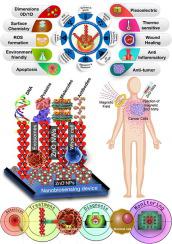Materials Today ( IF 21.1 ) Pub Date : 2021-08-09 , DOI: 10.1016/j.mattod.2021.07.025 Brandon Ortiz-Casas 1, 2 , Andrés Galdámez-Martínez 3 , Jorge Gutiérrez-Flores 3 , Andrés Baca Ibañez 1 , Pritam Kumar Panda 4 , Guillermo Santana 3 , Horacio Astudillo de la Vega 1 , Mrutyunjay Suar 5, 6 , Citlaly Gutiérrez Rodelo 1 , Ajeet Kaushik 7 , Yogendra Kumar Mishra 8 , Ateet Dutt 3

|
As bioapplications of 0D and 1D zinc oxide (ZnO) seem a recent development, they have brought many exciting proposals showing exquisite signs as sensors and assay platforms offering biomolecular selectivity and sensitivity for cancer diagnosis and treatment. Cancer researchers are looking for diagnostic and molecular instruments to identify the cancer-causing agents and subtle molecular shifts. The inclusion of high-performance ZnO materials due to their intrinsic properties such as viability, bio-acceptability, high isoelectric point, tunable morphology, etc., is promising for targeted detection and treatment processes. More specifically, ZnO nanowires (NWs) have offered the opportunity to yield new types of approaches against targeted cancer in contrast to their 0D counterparts. The ability of ZnO NW sensors to identify the molecular features (i.e., biomarker) of cancer and their integration portability has the potential to revolutionize cancer diagnosis and patient health monitoring timely and efficiently. Despite being robust, tunable properties based on surface chemistry and eco-friendly, scalable opportunities are yet to be explored. This review considers captivating research advances to identify and understand fundamental properties and examine various biosensing approaches and nanomedicine (via performing targeted drug delivery or therapeutic) aspects utilizing them while paying attention to different size regimes of ZnO NWs. The high-performance role of 0D and 1D ZnO as biosensors, capture devices, cell imaging complexes, or treatment is addressed on the bases of the controlled functions such as enhanced adsorption, reactivity, surface chemistry, cytotoxicity, and biocompatibility in various biological systems and models. With a comparative viewpoint, 0D and 1D ZnO nanostructures are going to emerge as breakthrough candidates for diagnostics and treatment of cancer effectively and efficiently.
中文翻译:

用于癌症诊断和治疗的生物可接受的 0D 和 1D ZnO 纳米结构
由于 0D 和 1D 氧化锌 (ZnO) 的生物应用似乎是最近的发展,它们带来了许多令人兴奋的提议,显示出精美的迹象,作为传感器和分析平台,为癌症诊断和治疗提供生物分子选择性和敏感性。癌症研究人员正在寻找诊断和分子仪器来识别致癌因子和细微的分子变化。包含高性能 ZnO 材料由于其固有特性,如活力、生物可接受性、高等电点、可调谐形态等,有望用于靶向检测和处理过程。更具体地说,与 0D 对应物相比,ZnO 纳米线 (NW) 提供了产生针对靶向癌症的新型方法的机会。ZnO NW 传感器识别分子特征的能力(即。例如,癌症的生物标志物)及其集成便携性具有及时有效地彻底改变癌症诊断和患者健康监测的潜力。尽管基于表面化学和环保、可扩展的机会具有强大的、可调节的特性,但仍有待探索。本综述考虑了引人入胜的研究进展,以识别和理解基本特性,并研究利用它们的各种生物传感方法和纳米医学(通过执行靶向药物递送或治疗)方面,同时关注不同尺寸的 ZnO NW。0D 和 1D ZnO 作为生物传感器、捕获装置、细胞成像复合物或治疗的高性能作用是基于受控功能,如增强的吸附、反应性、表面化学、细胞毒性、以及各种生物系统和模型中的生物相容性。从比较的角度来看,0D 和 1D ZnO 纳米结构将成为有效和高效地诊断和治疗癌症的突破性候选材料。











































 京公网安备 11010802027423号
京公网安备 11010802027423号